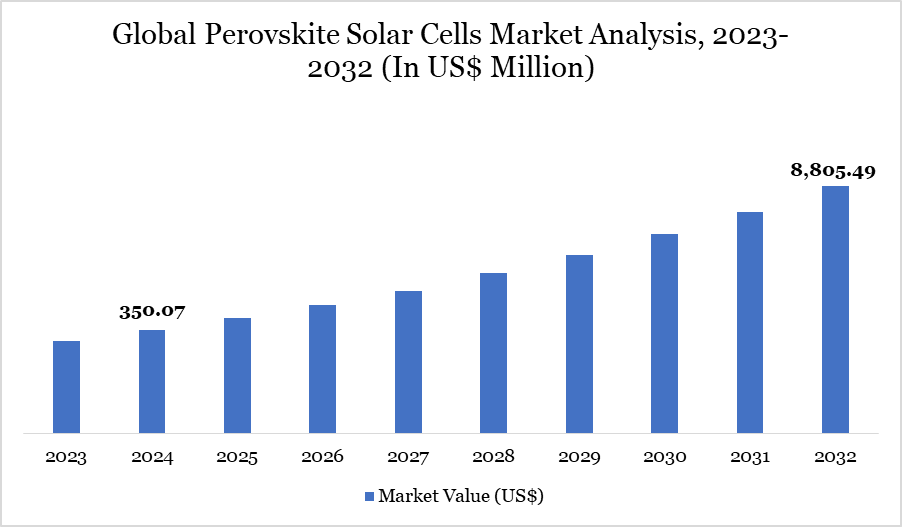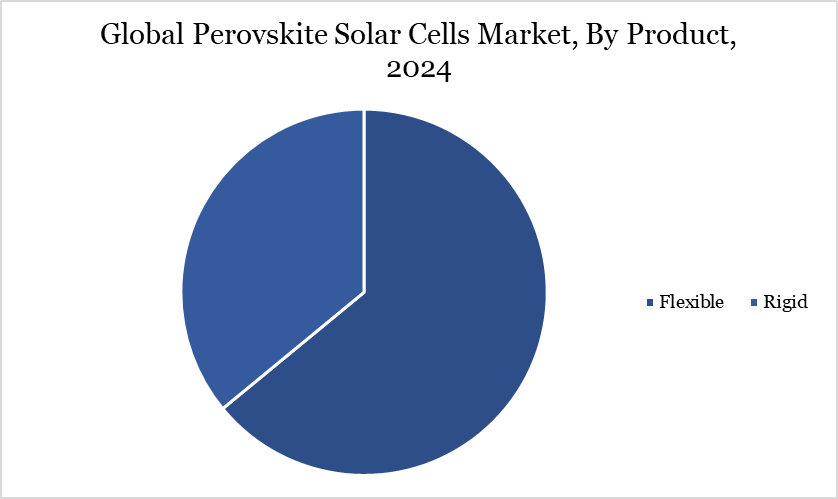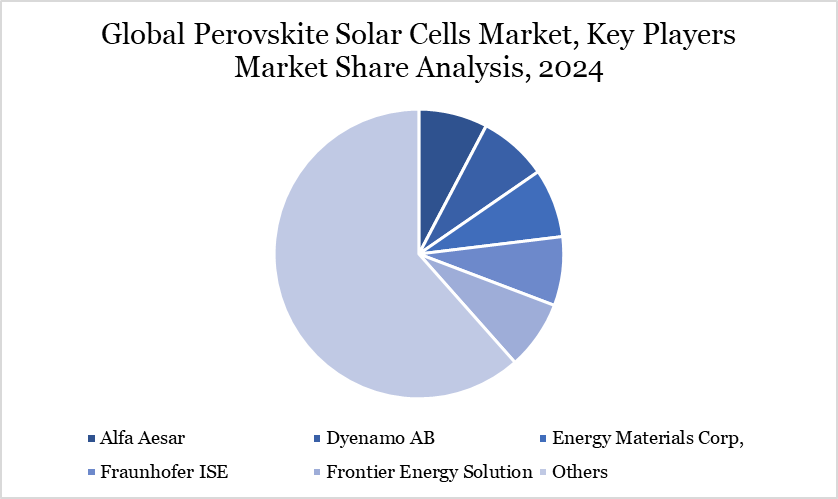Market Size
Global Perovskite Solar Cells Market size reached US$ 350.07 million in 2024 and is expected to reach US$ 8,805.49 million by 2032, growing with a CAGR of 38.05% during the forecast period 2025-2032.
Perovskite solar cells are cutting-edge photovoltaic systems that use a perovskite-structured compound, which is frequently made of materials based on tin halide or hybrid organic-inorganic lead. Their high-power conversion efficiency (PCE), which increased dramatically from 3% in 2009 to over 25% by 2021, has garnered a lot of interest for these cells. They are a possible substitute for traditional solar systems due to their effective conversion of sunlight into power, low production costs, and streamlined fabrication procedures.
Perovskite solar cells can be incorporated into a variety of architectural components and are lightweight and flexible. Even though they have a lot of commercial promise, issues like material durability and environmental stability still limit their practical use. These restrictions should be removed with more funding and technical developments, making perovskite solar cells a commonplace part of the world's renewable energy grid. Because of their distinctive qualities, they have the potential to completely transform the solar energy industry, particularly in applications involving building-integrated photovoltaics (BIPV).
Perovskite Solar Cells Market Trend
Technological developments, rising investment, and growing applications in building-integrated photovoltaics are driving dynamic trends in the perovskite solar cell market. Perovskite cells are increasingly being incorporated into products like walls, roofs, and windows to provide both architectural functionality and electricity generation at the same time.
The transition from conventional silicon-based solar technology to perovskite alternatives, which are more affordable and versatile, is a noteworthy trend. When compared to earlier photovoltaic technologies that required 1.1 billion RMB/GW (US $12.6 billion), the industrialization of perovskite solar cells started in September 2023 with significant private investments of about 500 million RMB/GW (US$ 5,753 million).
Adoption is being accelerated by favorable government incentives and rising demand for green energy solutions. Additionally, it is anticipated that the convergence of BIPV with IoT-based systems and smart homes will support market growth. These patterns highlight how perovskite technology can upend established solar businesses and sustainably meet the world's expanding energy needs.

For more details on this report – Request for Sample
Market Scope
| Metrics | Details |
| By Product | Rigid, Flexible |
| By End-user | Aerospace & Defense, BIPV, Solar Panel, Smart Glass, Others |
| By Application | Smart Glass, Solar Panel, BIPV, Others |
| By Region | North America, South America, Europe, Asia-Pacific, Middle East and Africa |
| Report Insights Covered | Competitive Landscape Analysis, Company Profile Analysis, Market Size, Share, Growth |
Global Perovskite Solar Cells Market Dynamics
Improving Accessibility and Solar Efficiency
The market for perovskite solar cells is primarily driven by the wide range of benefits these cells offer over conventional silicon-based solar technologies. Notably, even in low light or indoor environments, perovskite cells have a high-power conversion efficiency. They can catch a wider range of the sun spectrum because to their higher spectral absorption, which increases energy yield.
These cells are smaller and lighter, which makes them appropriate for a variety of uses, including BIPV goods and portable electronics. Perovskite solar cells are significantly less expensive than conventional panels because of their low manufacturing and material costs. Their inexpensive appeal is further enhanced by the fact that they may be printed utilizing straightforward methods.
These elements help to generate broad interest from public and private entities as the need for renewable energy rises, and more funds are being allocated to large-scale production and implementation. When taken as a whole, these benefits make perovskite solar cells the solar energy technology of the future.
Cloud Market Outlook Due to Toxicity Concerns
The market for perovskite solar cells is severely constrained by the health and environmental risks posed by their chemical makeup, notwithstanding their encouraging qualities. The existence of lead in perovskite compositions is a major worry. As these cells break down, harmful lead-based compounds like Pbl may be released, endangering both the environment and human respiratory systems.
Concerns over these materials' long-term ecological effects are heightened by their seeping into soil and water sources. Adoption may be constrained, especially in residential settings, by regulatory scrutiny and public fear of the possible discharge of harmful compounds. Strict handling procedures and the creation of lead-free or encapsulated substitutes are required due to these safety concerns. The environmental risk associated with perovskite solar cells continues to be a significant obstacle to widespread commercial adoption and long-term success in international markets until practical, sustainable formulations are generally accessible.
Market Segment Analysis
The global perovskite solar cells market is segmented based on type, application, end-user, and region.

Flexible Perovskite Solar Cells Driving Market Leadership Through Versatility and Innovation
The market is dominated by the flexible perovskite solar cell segment based on product type because of its versatility and broad range of uses. The growing need for flexible and lightweight solar technology in industries including consumer electronics, automotive, and building-integrated photovoltaics (BIPV) is a major development driver.
In contrast to traditional rigid panels, flexible perovskite solar cells can be integrated into curved and unusual surfaces since they can be made on substrates like plastic or metal foils. They are perfect for wearable and mobile electronics because of this property, which also increases their portability. Their ability to be integrated into intricate structures or flexible devices has made them the go-to option in situations when rigidity is a constraint.
Market Geographical Share
Europe's Leadership in Perovskite Solar Cells Through Innovation Policy and Sustainability
Europe is the biggest and most advanced market for perovskite solar cells, due to strong clean energy goals and enabling regulatory frameworks. Solar adoption has increased significantly as a result of the European Union's goal to obtain at least 32% of its energy from renewable sources by 2030.
With significant public and private investments in research and development, nations like the UK and Germany are spearheading the effort. The benefits of perovskite technologies, such as their high efficiency and inexpensive production, are in line with Germany's strong emphasis on sustainability and lowering carbon emissions.
With universities like Oxford University at the forefront of perovskite innovation, the UK benefits from a thriving academic research environment. Demand is also being driven by the growing popularity of smart energy systems and building-integrated photovoltaic (BIPV) applications. However, certain perovskite formulations contain lead, which poses regulatory issues. European parties are actively attempting to resolve these issues through innovation and policy improvement.
Sustainability Analysis
Perovskite solar cells (PSCs) have enormous potential to improve the sustainability of photovoltaic (PV) adoption globally, with the rapid shift to net-zero emissions. They are positioned as an affordable and environmentally responsible substitute for traditional silicon-based technologies due to their high-power conversion efficiencies, low manufacturing energy requirements, and utilization of plentiful components.
Their ability to work with low-energy, scalable processes like roll-to-roll manufacturing increases the likelihood that they will be widely used. Important sustainability issues still exist despite these benefits. These include the requirement for strong end-of-life waste management methods, challenges in scaling up lab-developed processes, and limited long-term operating stability brought on by ion migration and interface degradation.
Future research must concentrate on improving material stability, creating consistent, high-throughput production methods, and creating frameworks for the circular economy in order to realize their full potential. To guarantee that PSCs make a significant and long-lasting contribution to the global clean energy scene, these issues must be resolved.
Major Global Players
The major global players in the market include Alfa Aesar, Dyenamo AB, Energy Materials Corp, Fraunhofer ISE, Frontier Energy Solution, FrontMaterials Co. Ltd., FUJIFILM Wako Pure Chemical Corporation, G24 Power Ltd., Greatcell Energy, Microquanta Semiconductor Co. Ltd.

Key Developments
- In June 2024, At the 2024 Intersolar Europe in Munich, Germany, LONGi declared that commercial M6 size silicon Perovskite Tandem Solar Cells had achieved a new world record efficiency of 30.1%.
- In August 2023, at the Fujisawa Sustainable Smart Town in Fujisawa, Japan, Panasonic Holdings Corporation announced that the world's first long-term deployment and demonstration project of BIPV perovskite photovoltaics glass had begun
Why Choose DataM?
- Data-Driven Insights: Dive into detailed analyses with granular insights such as pricing, market shares and value chain evaluations, enriched by interviews with industry leaders and disruptors.
- Post-Purchase Support and Expert Analyst Consultations: As a valued client, gain direct access to our expert analysts for personalized advice and strategic guidance, tailored to your specific needs and challenges.
- White Papers and Case Studies: Benefit quarterly from our in-depth studies related to your purchased titles, tailored to refine your operational and marketing strategies for maximum impact.
- Annual Updates on Purchased Reports: As an existing customer, enjoy the privilege of annual updates to your reports, ensuring you stay abreast of the latest market insights and technological advancements. Terms and conditions apply.
- Specialized Focus on Emerging Markets: DataM differentiates itself by delivering in-depth, specialized insights specifically for emerging markets, rather than offering generalized geographic overviews. This approach equips our clients with a nuanced understanding and actionable intelligence that are essential for navigating and succeeding in high-growth regions.
- Value of DataM Reports: Our reports offer specialized insights tailored to the latest trends and specific business inquiries. This personalized approach provides a deeper, strategic perspective, ensuring you receive the precise information necessary to make informed decisions. These insights complement and go beyond what is typically available in generic databases.
Target Audience 2024
- Manufacturers/ Buyers
- Industry Investors/Investment Bankers
- Research Professionals
- Emerging Companies